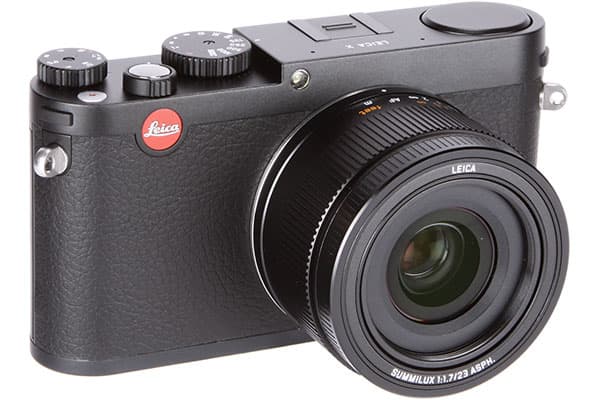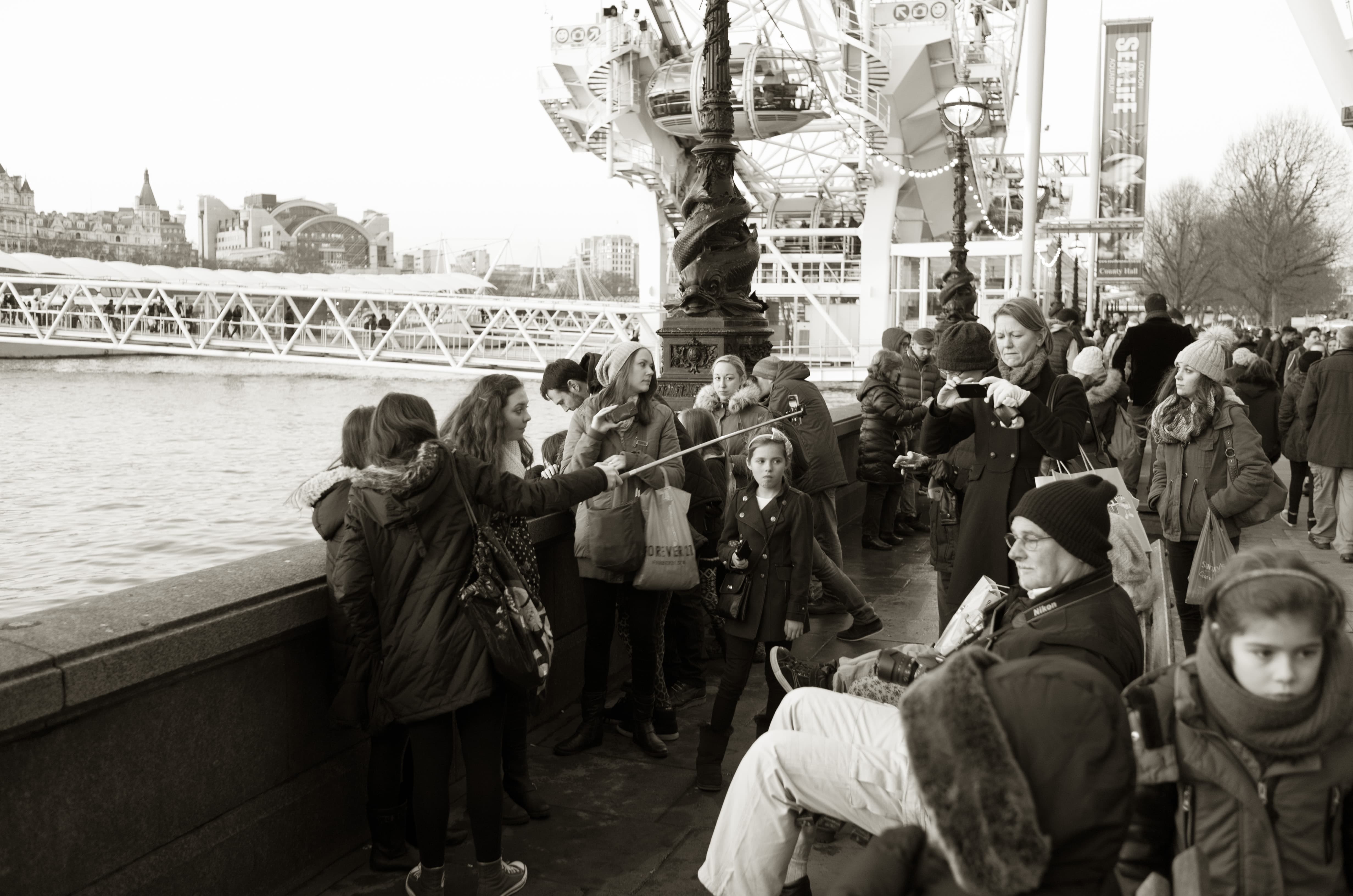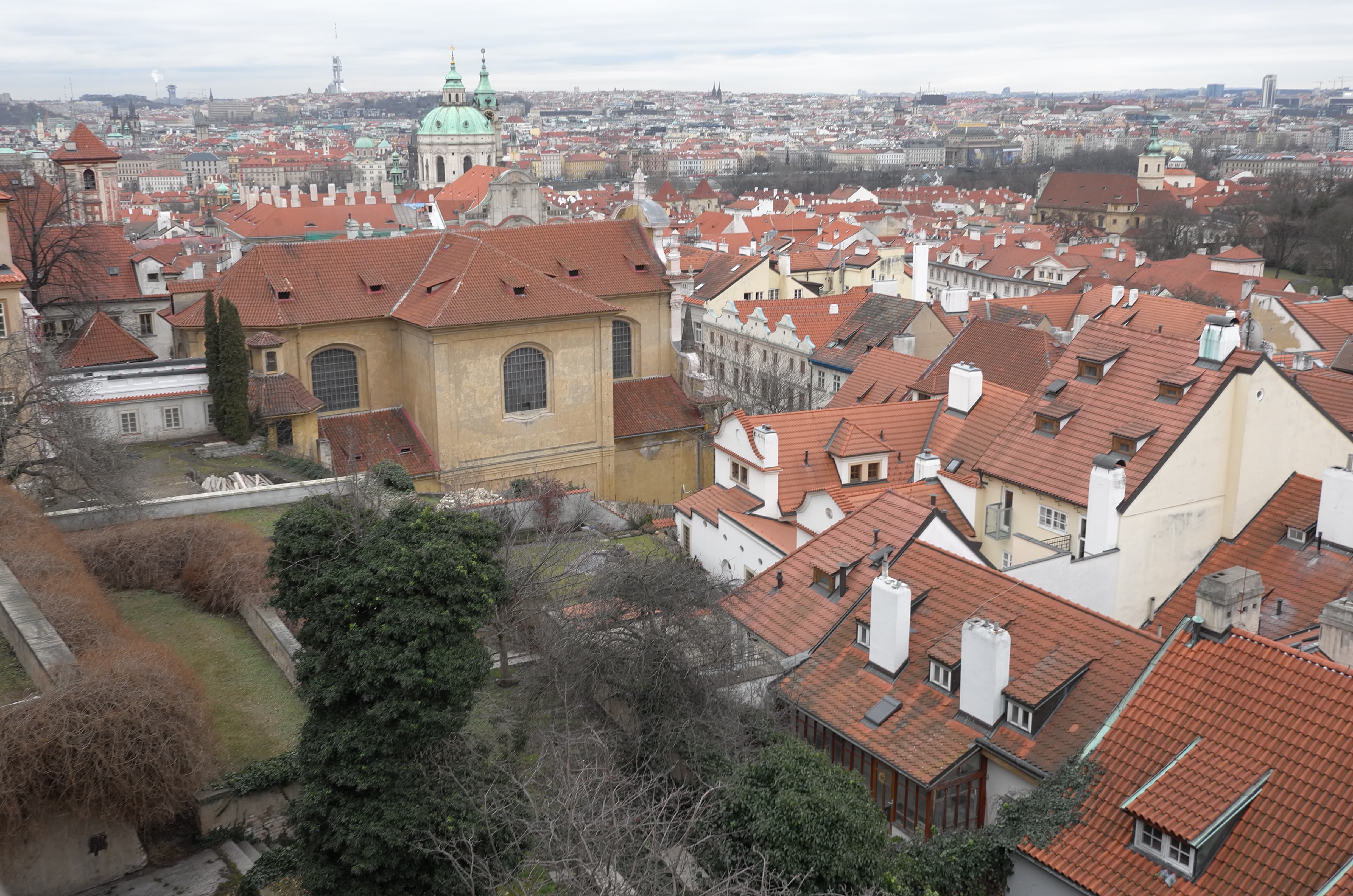If there’s one badge guaranteed to make photographer’s pulses race just that little bit faster, it’s the iconic red dot of Leica. The German company has been making cameras for 90 years, and its M-series rangefinders are perhaps the most desirable on the planet – and among the most expensive.
Leica X (Typ 113) Review – at a glance
- 16.2-millon-pixel, APS-C CMOS sensor
- 35mm (equivalent) f/1.7 lens
- ISO 100-12,500
- 3in, 920,000-dot LCD
- 1/2000sec maximum shutter speed
- Available in black, or silver and brown
- Price £1,550
Like other manufacturers, Leica has had to adapt and reinvent itself for the digital era. It still makes M-mount rangefinders, but its expanding product range also includes the S-system medium-format DSLR and the T-system compact system camera. At the other end of the scale, it sells its own reworked versions of Panasonic cameras, including the superb D-Lux, which is based on the Lumix DMC-LX100 with its Four Thirds sensor and fast zoom lens. In the middle lies the X range of fixed-lens, APS-C-sensor compacts.
The Leica X (Type 113) is in essence a development of the earlier Leica X2, which featured a retro design with analogue control dials and a fixed 23mm f/2.8 lens. The X is a larger camera with a significantly faster lens – its 23mm f/1.7 gathers a stop and a half more light, making it the fastest prime on any current fixed-lens camera. Meanwhile the X2 gets a cosmetic refresh, and continues in the range as the X-E.
The X is available in a discreet all-black finish, which we expect will be appreciated by photographers who wish to remain inconspicuous. There’s also a rather handsome two-tone brown-and-silver model (follow the link to see our hands-on pictures of this version).

Take a look at our Leica X image samples gallery
Leica X (Typ 113) Review – Features
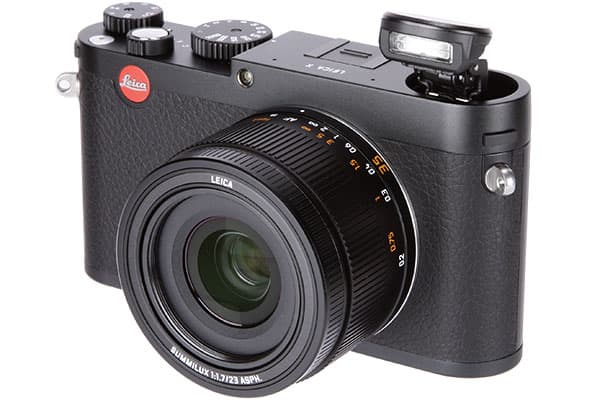
The built-in flash pops up from the top plate
In an age of ever-increasingly complicated cameras, the Leica X is something of a breath of fresh air. It’s a very simple camera at heart, with few fripperies or distractions. Essentially, it’s a camera that’s primarily designed for one purpose alone – shooting still images.
To this end, it has a 16.2-million-pixel, APS-C CMOS sensor, which is shared with other Leica models including the T compact system camera, the X-E, and the zoom-lensed X-Vario. The Summilux 23mm f/1.7 Asph lens has a complex design with ten elements in eight groups, including two aspheric lens elements to reduce distortion and aberrations. It can focus as close as 0.2m and is threaded for 43mm filters. Unscrewing a metal ring at the front of the lens reveals an outer 58mm thread, which is designed to allow attachment to Leica’s APO-Televid spotting scopes.
A sensitivity range of ISO 100-12,500 is available, and the X includes a useful Auto ISO program that allows you to set both the highest sensitivity and the minimum shutter speed that you’re happy to use. This is helpful because it enables you to manage the risk of blur from handshake – I personally set the minimum shutter speed to 1/60sec and let the camera use the entire sensitivity range. At this point, it’s worth noting that the X has no optical image stabilisation, and while a dual-exposure-based electronic stabilisation system can be turned on in the menu, it’s not terribly useful.

Leica X front view, showing the fast 23mm f/1.7 lens
Continuous shooting is available at a respectable 5ps or 3fps, with focus and exposure fixed after the first frame and a seven-shot raw buffer. Two self-timer modes give shutter release delays of 12secs and 2secs – the latter is particularly valuable for tripod-based, long-exposure work, as there’s no remote shutter release.
Video recording is available at full HD 1920 x 1080-pixel resolution and 30fps in MP4 format, with sound captured by built-in stereo microphones. It has remarkably few options: you can enable a wind cut filter, turn electronic image stabilisation on or off, or drop the resolution to HD 1280 x 720-pixel resolution. But that’s your lot. You get no manual exposure control in video – the camera simply adjusts the brightness according to whatever it consider best – but manual focus adjustment is possible during recording.
The small pop-up flash is released by a sliding switch on the back of the camera. Alongside auto and forced-flash modes, there’s also an option for triggering studio strobes by disabling the metering pre-flash. A hotshoe on the top-plate can be used to mount more powerful external units – it also has contacts allowing the use of the Visoflex (Type 020) electronic viewfinder that’s also used by the Leica T.
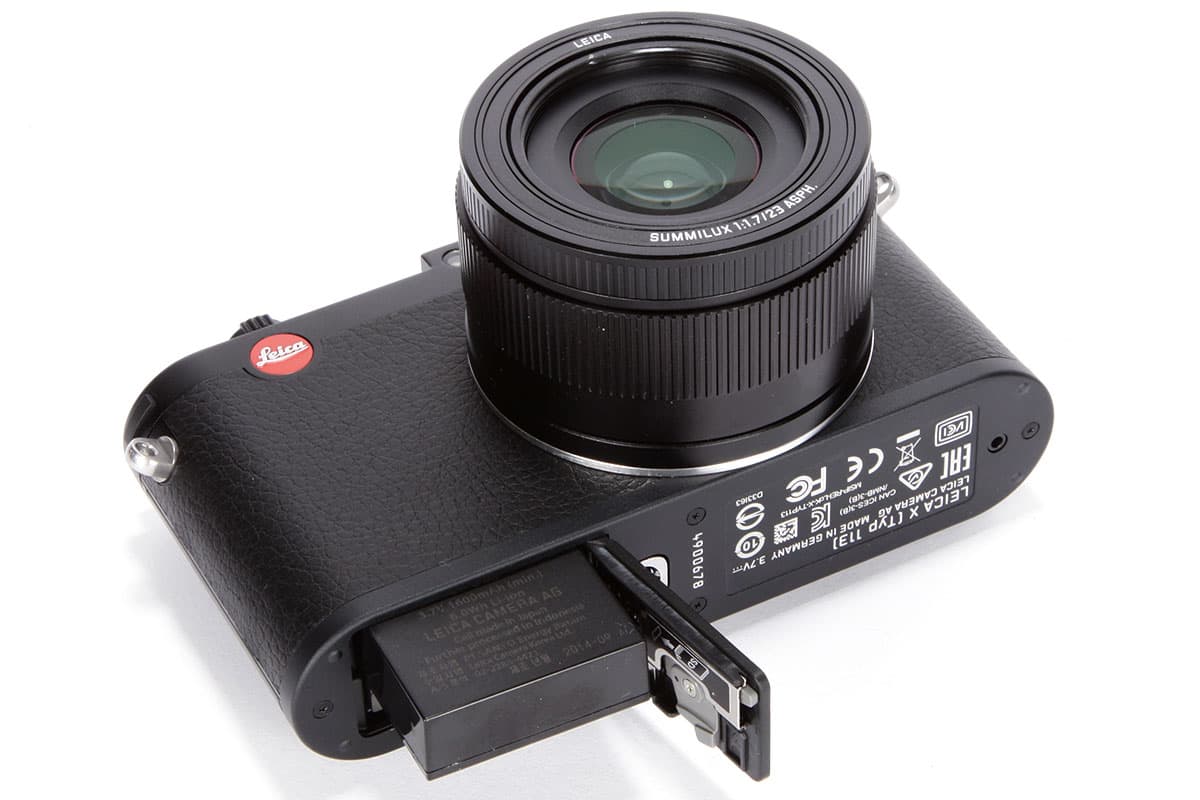
The battery is rated for 350 shots
A door on the camera’s side opens to reveal standard mini USB and mini-HDMI ports for connection to computers and TVs, and a baseplate compartment accepts the battery and SD card. The BP-DC8 battery is rated for 350 shots per charge, and is replenished using the supplied AC charger.
What’s perhaps just as notable about the Leica X is the features it lacks. For example, there are no button customisation options, dynamic range expansion modes, built-in Wi-Fi, or electronic levels display. These are all genuinely useful features, and while I admire the X’s pared-down philosophy, I do wonder if it’s gone a bit too far.
Build and handling
Leica X (Typ 113) Review – build and handling
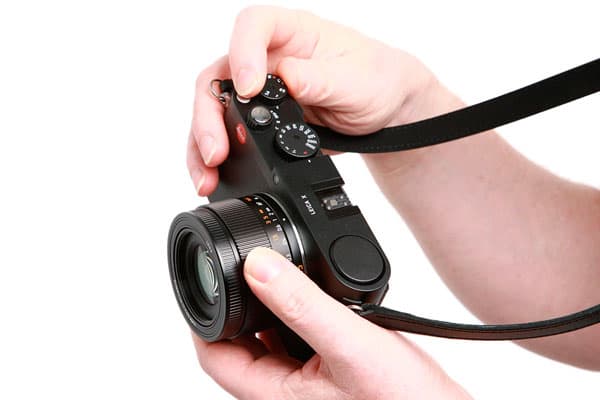
The X has a large manual focus ring and top-plate dials for shutter speed and aperture
It’s a £1,500 camera that proudly proclaims it’s assembled in Germany, and this means we inevitably have high expectations of the Leica X’s build quality. Fortunately they are, to a great extent, met: the body feels solidly constructed thanks to its all-metal shell, and the various buttons operate with satisfyingly positive clicks. If I have a criticism, it’s that the click stops on the top-plate controls are insufficiently firm, so it’s a little too easy to knock the shutter speed or aperture dials, or inadvertently set the power/drive mode switch to continuous mode.
The body design is almost identical to the X-Vario APS-C zoom compact. Of course, the lens is different – it’s less bulky and doesn’t have a zoom ring – but aside from that the main physical change is the deletion of the X-Vario’s EVF port from beneath the hotshoe. At 133 x 73 x 78mm in size, and 486g in weight, the Leica X isn’t a small camera, and tellingly, it’s a bit more bulky than either of its most obvious competitors – the Fujifilm X100T and the full-frame Sony Cyber-shot DSC-RX1R.

Shutter speed and aperture dials are mounted on the top plate. The shutter button is surrounded by a power/ drive mode switch, with ‘S’ for single can C’ for continuous. The small button with the red dot in its centre is for video recording.
With Leica’s signature rounded, rather than squared-off ends, the X fits nicely in your hand, and the textured finish means that it feels quite secure despite the absence of a handgrip. It sports small shutter speed and aperture dials on the top-plate, and exposure compensation is handled by an electronic dial just under your thumb, which also navigates menus and sets shutter speeds longer than 1sec. Other key settings – ISO, white balance and autofocus mode – have dedicated buttons on the back of the camera. Overall, it’s simple and it works pretty well – experienced photographers will find their way around in no time at all.
Viewfinder and screen
Leica X (Typ 113) Review – viewfinder and screen
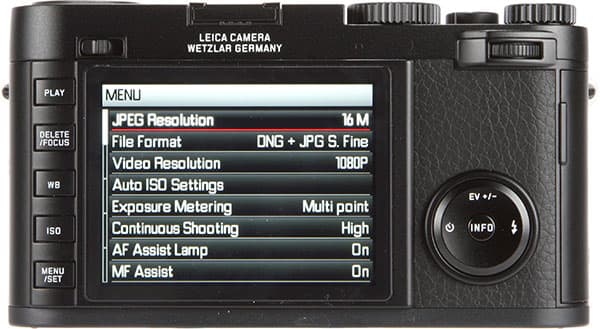
The Leica X’s LCD is a fixed 3″ 920,000 dot unit
The Leica X has a 3in, 920,000-dot LCD screen with a 4:3 aspect ratio, which is basically the standard we’d expect from a £1,500 camera. In use, it’s sharp, bright and detailed, and quite visible in bright sunlight. It’s neither touch-sensitive nor articulated in any way, but like it or not, that’s normal for a fixed-lens compact.
The camera offers a number of display modes while taking pictures, but to be honest, none of them are totally satisfactory. The most basic one shows the preview image with exposure data shown on a black bar above it: shutter speed and aperture are included, but not ISO (although oddly, metering mode is). It is possible to show more detailed shooting data, including such things as focus mode, ISO and shots remaining, but this is placed on translucent grey overlays across large swathes of the image, which really distracts from composition. A third mode offers a live histogram and rule-of-thirds gridlines, which I generally preferred, but the large histogram display has a solid grey background and therefore completely blocks part of the image.
It’s also possible to use the add-on Visoflex EVF, which essentially duplicates the camera’s display modes in an eye-level finder that can also tilt 90° upwards for shooting at awkward angles. It’s a very good finder – large, sharp and detailed – but at £400 it’s very expensive, and when mounted it adds considerable bulk.
Focusing
Leica X (Typ 113) Review – focusing
If the Leica X has a weak point compared to its peers, it has to be focusing. I found that the autofocus, while accurate, simply isn’t as fast as its peers. This isn’t a big problem for static subjects, but it does mean that the camera isn’t necessarily the best choice for anything that moves.
Pressing the AF button allows you to select between modes, including multi-area, single point or spot (which uses a smaller focus area for improved accuracy). Holding the button down for a second ‘activates’ the focus area, allowing you to move it around the frame using the D-pad to match your subject. I found this was quite a slow process, so generally used the centre point and recomposed instead. Other cameras offer more direct approaches to moving the focus area.
Of course, you can always switch to manual focus, which is accomplished by simply rotating the focus ring away from its AF position. There’s a simple distance scale, but no depth-of-field scale for zone focusing, which is a bit disappointing. The only manual focus aid is an optional magnified view. But critically, the X doesn’t necessarily open its aperture up fully for manual focus, making it impossible to focus accurately in bright light. For a camera of this type, this is unacceptable (especially as the old X1 had the same problem, and Leica fixed it with a firmware update).
Performance
Leica X (Typ 113) Review – performance
The proof of the pudding is in the eating, and what we really want to know is whether the camera offers image quality to match the price. At this point it’s all too easy to jump in and analyse sensor performance alone, but in this type of camera, the optics are at least as important.
Leica is famed as a lens maker, and in general the 23mm f/1.7 Asph Summilux doesn’t disappoint. It’s pretty sharp wide open, and is at its best around f/4-f/8, before diffraction softening becomes visible. Chromatic aberration is very low, and distortion is completely invisible in the camera’s JPEG output. A little digging into the DNG raw files shows that this is because Leica is following current best practice of allowing residual barrel distortion so as to minimise aberrations towards the corners, then correcting it in software. Most of the time this is completely transparent, and modern raw converters will take it all in their stride.
There is a catch though – at closer focus distances the lens almost inevitably becomes a little softer, which is common with fast primes due to spherical aberration. Leica’s solution is to automatically stop the lens down as you focus closer, to maintain image quality. So at 1m it only allows a maximum aperture of f/2, reducing to f/2.5 at 0.7m and f/2.8 at 0.45m or closer. On one level this is very clever, guaranteeing a certain level of sharpness, but personally I’d prefer to be able to make my own choice, and trade-off sharpness against background blur. As it is, these aperture restrictions rather negate the X’s main advantage compared to the Fujifilm X100 – that is, its faster lens, for subjects like portraiture.
The sensor performs much as we’d expect from a recent APS-C design, but I can’t say I’m a fan of Leica’s JPEG processing. The default colour mode is a little bland and uninspiring, not helped by the auto white balance’s tendency to overneutralise, and while the vivid colour mode is more punchy, it goes too far for my taste. Sharpening is heavy-handed, giving obvious haloes, and high ISO noise reduction is rather conservative (that is, ineffective). It’s possible to tweak output settings in the menu, but personally I’d shoot raw for colour. Here the X has the advantage of recording widely readable DNG-format raw files, and the camera ships with Adobe Lightroom in the box.
I actually spent most of the time shooting in B&W high contrast mode, simply because it worked better in the dull grey winter weather I encountered during my time with the camera. I like the tonality it delivers, and think it’s rather well suited to the classic Leica reportage aesthetic. Of course. you can get better results shooting raw and post-processing, but it’s always nice to see good-looking files out of the box.
Image quality
Leica X (Typ 113) Review – image quality
The Leica X uses a 16-million-pixel APS-C CMOS sensor, most likely a version of the stalwart Sony design that’s been used for over three years. This is in no way a bad thing, as it’s a very good sensor indeed. It may look dated in comparison to newer 24-million-pixel designs, but the X’s excellent lens makes the most of the pixels, giving sharp images across the frame.
To get the most from the camera, though, you need to shoot raw and process yourself, which will reveal more detail than Leica’s somewhat unrefined JPEG processing. Few modern camera show such a large disparity between JPEG and raw.
Resolution
It’s in our resolution tests that Leica’s JPEG processing most clearly shows its limitations. At around 2600l/ph at ISO 100, it lags well behind raw, which can yield almost 3200 l/ph. Indeed this is essentially at the theoretical limit for the sensor, implying that Leica hasn’t installed an optical low-pass filter. The large APS-C sensor means that resolution doesn’t suffer immediately as the sensitivity is increased, only dropping to around 2800 l/ph at ISO 1600 in raw. Thereafter it falls more quickly, to about 2200 l/ph at ISO6400, and 2000 l/ph at ISO 12500.
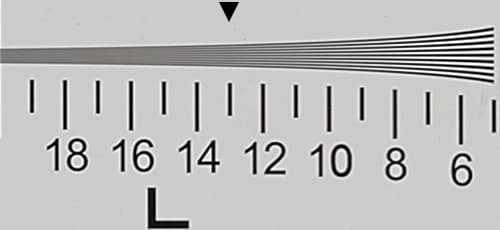
Leica X resolution – ISO 100 JPEG. Note the haloes from wide-radius sharpening
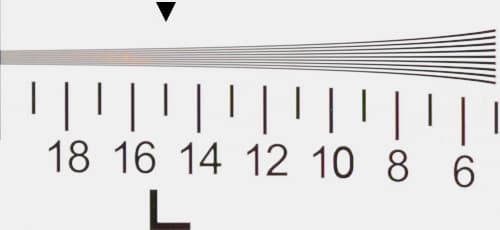
Leica X resolution – ISO 100 RAW. More subtle processing maintains fine detail better
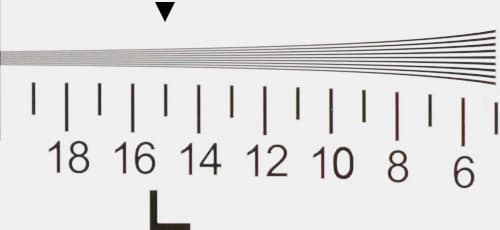
Leica X resolution – ISO 200 RAW

Leica X resolution – ISO 400 RAW

Leica X resolution – ISO 800 RAW

Leica X resolution – ISO 1600 RAW
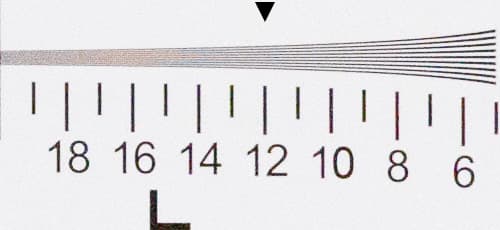
Leica X resolution – ISO 3200 RAW

Leica X resolution – ISO 6400 RAW
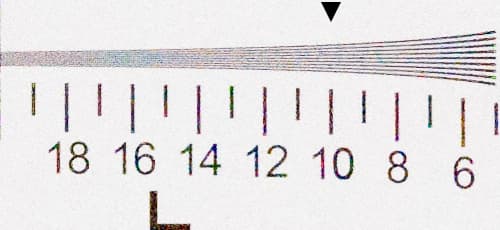
Leica X resolution – ISO 12500 RAW
Image quality: Dynamic Range
Leica X (Typ 113) Review – Image quality: Dynamic Range
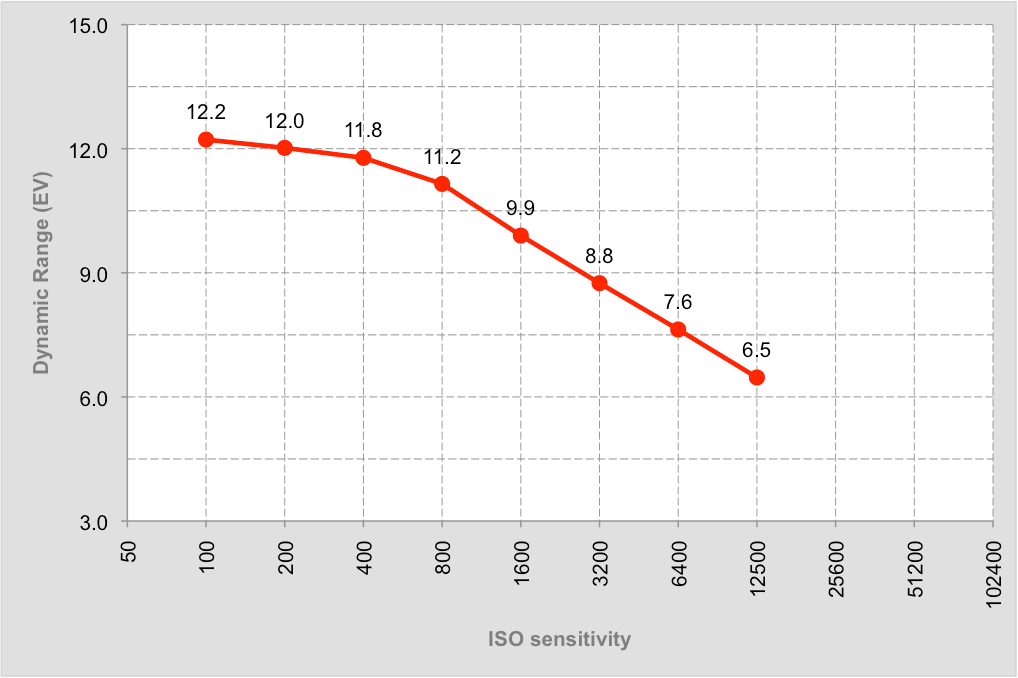
Leica X Dynamic Range
Looking at the dynamic range chart shows reasonable results for an APS-C sensor. Our Applied Imaging tests reveal a dynamic range of 12.2 EV at ISO 100, which drops off only gradually up to ISO 800, where we see a perfectly respectable 11.2 EV. But beyond this, it falls more quickly as noise becomes in increasing problem, and at ISO 3200 it reaches a just-about-acceptable 8.8 EV. The two higher settings give decidedly low range, indicating that there’s likely to be excessive noise in the shadows. So we’d avoid using ISO 6400 and 12500 if possible (indeed the camera will override these settings if the light is sufficient).
Real world example
In practical use, the Leica X’s dynamic range at low ISOs allows you to recover shadow detail that would ordinarily be lost in the camera’s JPEGs. The example below illustrates this. The default Adobe Camera Raw conversion has little shadow detail, but adjusting the Shadows slider brings up plenty more detail in the doorway without excessive noise.
Image Quality: Detail and Noise
Leica X (Typ 113) Review – Image quality: Detail and Noise
In its JPEG Standard mode, the Leica X gives distinctly muted colours, and strong sharpening haloes are visible around high contrast edges. Images look very clean at low ISOs, but luminance noise starts showing up in the shadows at ISO 800. As we move further up through the range, we see obvious chroma noise at ISO 1600, and solid colours start to bleed into each other. By ISO 6400 shadows are blocking up completely to conceal noise, and ISO 12500 is barely usable due to noise and noise reduction.
Much better results can be had from raw, which can give stronger colours, more effective noise reduction, and vastly better rendition of fine detail. With careful processing and noise reduction we can coax vastly better results from high sensitivity settings, with even ISO 6400 looking reasonably useable.
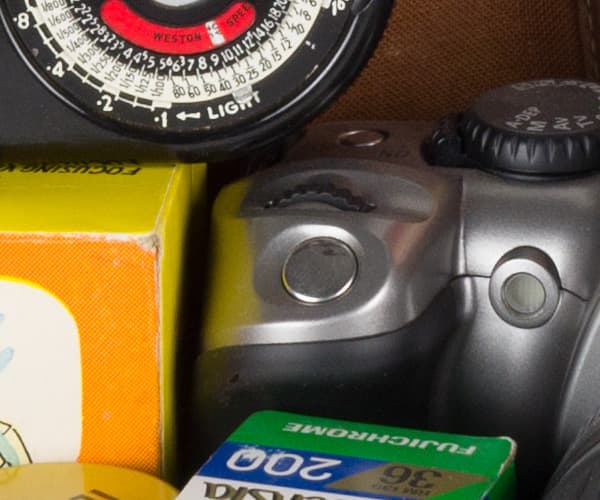
Leica X ISO 100 Raw
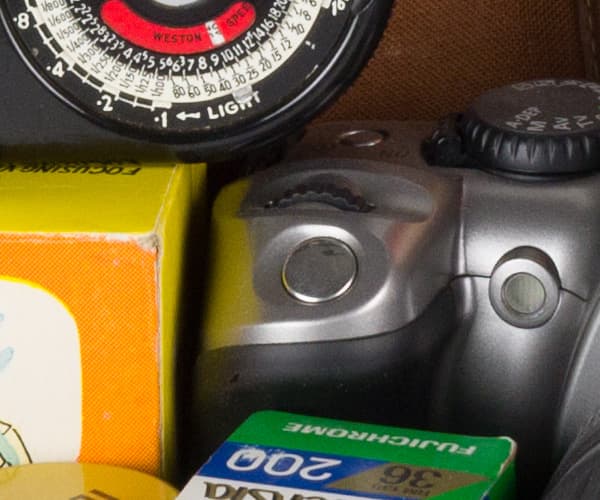
Leica X ISO 200 Raw
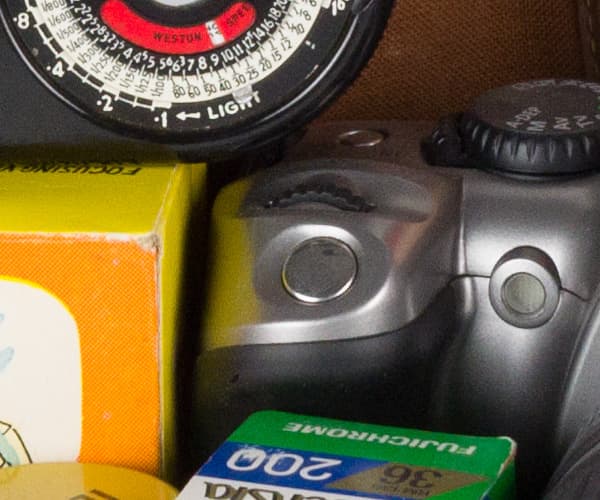
Leica X ISO 400 Raw

Leica X ISO 800 Raw

Leica X ISO 1600 Raw
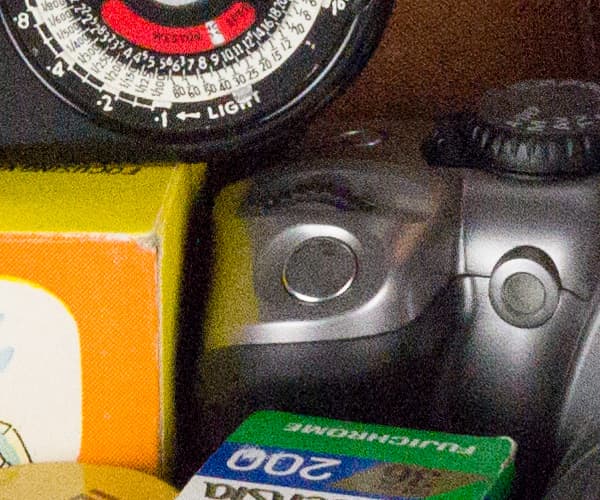
Leica X ISO 3200 Raw

Leica X ISO 6400 Raw
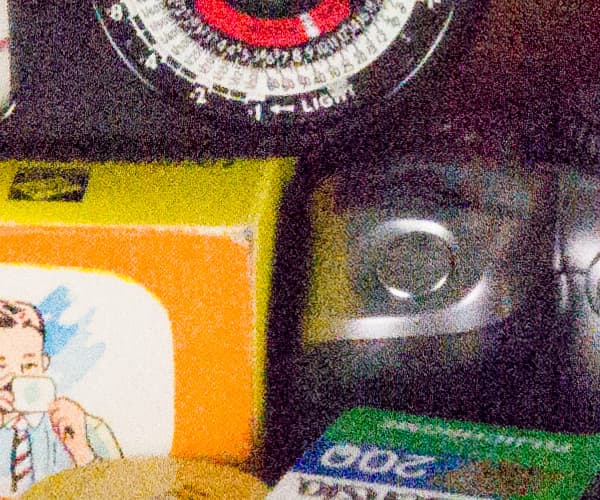
Leica X ISO 12500 Raw
Conclusion
Leica X (Typ 113) Review – conclusion

There’s plenty to like about the Leica X. It looks like a ‘proper’ camera, it feels great in your hand and it’s refreshingly simple to use. Indeed, with its fast prime lens and top-plate shutter speed and aperture dials, it encourages a creative approach to shooting that’s more akin to using a rangefinder than a conventional compact.
The lens is beyond reproach, giving impressive results wide open and getting even better stopped down. The sensor produces output every bit as good as we’d expect from a 16.2-million-pixel APS-C design, too. I’m really not a fan of Leica’s JPEG processing, particularly in terms of colour rendition, and was much happier with the results I got from shooting raw and post-processing. Here, Leica’s decision to use the open standard DNG format, and include a licence for Adobe Lightroom, pays dividends.
Unfortunately, there are a few areas where the camera falls short. The relatively slow autofocus and unreliable manual focus are its biggest flaws, and I really don’t like Leica’s decision to restrict the available maximum aperture for closer focus distances (I’d prefer to make that choice myself). I’d love to see a firmware update fixing these issues, which I think would improve the X substantially. The lack of an analogue exposure compensation dial also stands out, given the increasing popularity of this control on other cameras, but in practice the electronic thumb dial does much the same job.
Ultimately, though, the elephant in the room is the Fujifilm X100T, which manages to be faster, offer more external controls, include a viewfinder, and give excellent JPEG output, all at two-thirds of the price. Rationally, it’s a better choice in almost every way. But rationality doesn’t always come into it with Leica – the lure of the red dot can be hard to resist.


